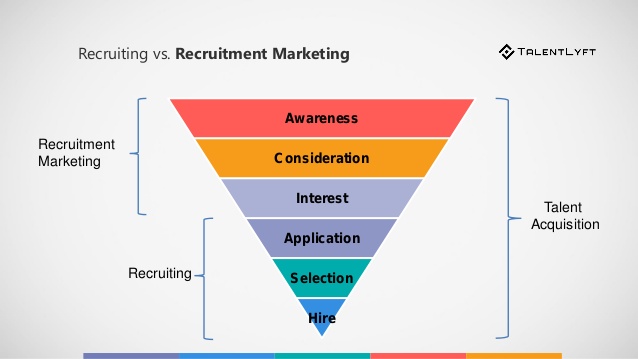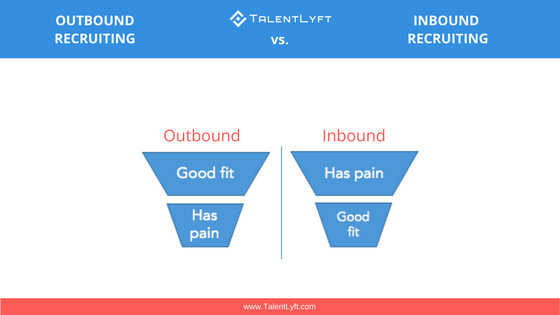![https://adoptoprod.blob.core.windows.net/article/R9rQgzQhYk2l3JMIT1C09A.png?7332]()
Difference Between Inbound and Outbound recruiting
There are two basic types of recruiting - outbound recruiting and inbound recruiting. These terms have become an HR buzzword in recruiting and everyone is talking about them. But what do they really mean? And what’s the difference between inbound recruiting and outbound hiring?
In short...
In inbound recruiting, or inbound recruitment, candidates come to you.
In outbound recruiting, or outbound hiring, you have to search for the candidates.
Inbound and Outbound recruiting focus on different stages of candidate journey
Inbound and outbound recruiting are different recruiting philosophies and strategies with different approaches and tactics, but the same end goal: hiring the perfect candidate persona.
Inbound recruiting (or inbound recruitment) is a recruiting strategy where you proactively and continually attract candidates with the goal to make them choose you as their next employer.
Your goal in inbound recruiting is to lead the candidates through the first 3 stages of candidates journey: Awareness, Consideration and Interest.
Outbound recruiting (or outbound hiring) is a recruiting strategy where you search for and contact candidates when a certain new position that you need to fill opens.
Your goal in outbound recruiting is to jump right to the application stage and offer your job opening.

Inbound and Outbound recruiting are long and short-term recruiting solutions
If you are looking for a long-term solution to advance your recruiting and hiring strategy, inbound recruiting is the way to go. With inbound recruiting, your goal is to build such an Employer Brand that will continually grow your pool of high-quality applicants.
Many companies have already adopted inbound recruiting as a preferred strategy. Even though it takes some time to see the results, in the long run, their time, cost and quality of hire have improved dramatically.
On the other side, there is outbound recruiting or outbound hiring. Outbound hiring is considered as a short-term recruiting solution because it is only used when a need arises. If outbound recruiting is your only recruiting strategy, start thinking about implementing inbound recruiting.
With so much information competitors share about themselves with the talent, you not doing the same will cost you. Simply reaching out to the candidates and offering an open position is not the way to attract talent anymore.
Inbound and Outbound Recruiting Are Like Inbound Marketing and Outbound Sales
We often hear as saying: “Candidates should be treated like customers!”.
We can approach them using inbound marketing methods, or we can do so using outbound sales methods.

The goal of inbound marketing is to have customers figure out their own pain points by reading relevant content. In recruiting, those pain points may include anything from a bad cultural fit to a lower than desirable salary.
After realizing that there is a pain-point, candidates, reading your content, employee testimonials, benefits and company stories, realizes themselves that your company is a better fit for them.
Outbound recruiting, same as outbound sales, uses a method in which recruiters find candidates who may be a good fit. After that, they call candidates to find out if there is a pain-point. In most cases candidates either don’t know that the pain-point exists, or they wouldn’t admit it.
Recruiting Inbound and Outbound way: Example
Imagine this situation: you have a job opening. How do you fill it?
If you did it inbound recruiting way, you have already provided all the useful and relevant information the candidate would want to know about your company. In other words, you have already showcased your Employer Brand on various online and offline channels that candidates use, to get them interested in working for your company.
If you did it outbound recruiting way, you have searched for a potential candidate, reached out, and offered your job opening.
Check out the visual representation of the differences between inbound recruiting and outbound hiring:

Inbound vs. Outbound recruiting: Which one is better (for you)?
Most companies use both inbound recruitment and outbound recruiting methods.
However, an outbound hiring method is more and more often considered as a plan B recruiting method. In other words, an outbound recruiting method is used only when you don’t manage to get high-quality applicants with your inbound recruiting strategy.
The goal of every inbound recruiting strategy is to continually attract talent and build your talent pools. Once you have a pool of high-quality talent, it is much easier to fill your open positions.
If you, however, don’t have a candidate that perfectly matches your hiring needs, you should switch to an outbound recruiting method.
One of the most popular outbound recruiting methods is candidate sourcing. Talent Acquisition leaders use sourcing only after they have confirmed that their current talent pool is missing the candidate persona they are looking for.
As mentioned earlier, if you are looking for a long-term recruiting solution, inbound recruiting is the way to go. I can promise you, there is the way to go to improve your recruiting and hiring productivity.
How to apply Inbound and Outbound recruiting strategies?
Inbound recruiting strategy
In inbound recruiting, your goal is to attract candidates to start considering you as their next employer. First, think about the type of candidates you want to attract. Identify your hiring needs, and job positions to fill. If you are the hiring manager, you will write a job requisition and send it out for approval.
The next step is writing job descriptions for those positions. Writing a good job description is the very first step in finding qualified candidates. (If you need help or ideas, check out these job description templates and examples).
Next, move on to defining your candidate persona. Following, think about your company culture. It’s crucial to hire the best talent that makes a perfect fit. The real fun begins when you have a clear picture of the type of candidates that you want to attract.
Now you have to give them a reason to choose your company as their next employer! Create compelling blogs posts, videos and social media content in which you’ll introduce your team and showcase your company culture and employee value proposition. Give them a reason to start dreaming about joining your team! 🙂

Once you spark their interest, make it easy for them to contact you and apply for your positions.
Make sure you have a wonderful career site with a simple application form.
Get our guide for optimizing career site!
Outbound recruiting strategy
Your goal in outbound recruiting is to jump right to the application stage and offer your job opening. But the way we recruit has changed. The war for talent is ranging on and it takes much more to attract talented people than just promote your job opening.
You have to proactively and selectively search for individual candidates with specific skills, experiences and knowledge.
In cases when inbound recruiting doesn’t work, effective sourcing tools are your best bet! Powerful sourcing tools can help you find perfect-fit candidates by scanning resumes, databases, niche sites, forums, blogs, social media platforms etc.
Attending specialized conferences, educational seminars and similar events are also a great way to meet potential candidates.
When you finally find that perfect candidate, think carefully about how to approach them. Try to find out as much as possible about the candidates wants and needs. Identify an employee value proposition that you can offer them, and convince them to join your team. Good luck! 🙂
Take your recruiting strategy to a whole new level!
If you want to take your recruiting strategy to a whole new level, think about using recruitment software. Start by identifying your recruiting goals and challenges to understand which recruiting tool would make your perfect fit.
If you use inbound recruiting, you’ll love our TalentLyft Engage and Convert solutions.
If outbound recruiting is the way you recruit, you should totally check out our TalentLyft Source solutions.
Improve your recruitment strategy with TalentLyft
Try our services for free for 14 days with no credit card required to sign up and a possibility of cancelation at any time! Once you are in the free trial, you can let our team know about your needs in the live chat. We will help you set up and source the best candidates out there!
Try now Frequently asked questions
What is the Difference Between Inbound and Outbound Recruiting? Inbound recruiting is a strategy where companies attract candidates and encourage them to choose the company as their next employer. It involves creating and sharing engaging content and building a strong employer brand. Outbound recruiting, on the other hand, is where the company actively searches for candidates, often for specific roles that need immediate filling.
How Does Inbound Recruiting Benefit Long-term Recruitment Goals? Inbound recruiting benefits long-term recruitment goals by building a pool of interested and qualified candidates over time. It focuses on creating a strong employer brand and nurturing potential candidates through engaging content and positive experiences, which can lead to a continuous stream of quality applicants.
When is Outbound Recruiting More Appropriate? Outbound recruiting is more appropriate when there is an immediate need to fill a specific position, and there are no suitable candidates in the existing talent pool. It involves actively searching for and reaching out to potential candidates through methods like sourcing tools, attending events, or utilizing professional networks.
How Can Companies Implement an Effective Inbound Recruiting Strategy? To implement an effective inbound recruiting strategy, companies should focus on defining their ideal candidate persona, creating compelling content (like blog posts and videos), optimizing their career site, and leveraging social media to showcase their culture and employee value proposition.
What is the Relationship Between Recruiting and Marketing in Inbound Recruiting? In inbound recruiting, the relationship between recruiting and marketing is significant. Just like inbound marketing, inbound recruiting attracts candidates through relevant and engaging content. This approach treats candidates like customers, drawing them in with a compelling employer brand and the promise of a fulfilling work experience.
![Boolean Search for Recruiters [Actionable Guide]](https://adoptoprod.blob.core.windows.net/article/7wyu_xAg806Tm_lmFg71Rw.png)



















